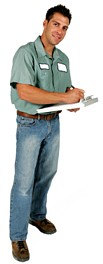Childproofing the Outside
The outside areas around a dwelling often consist of a combination of area you control and area you don’t. Sometimes there is a common area shared with other residents of a multifamily dwelling. In either case, some care must be taken to create a safe area for children, whether they’re playing there, or just passing through.
Discarded Materials
Cigarette butts, animal droppings, beer cans, and garbage all need to be cleared. You may or may not encounter the first three, but most buildings have an outside place to keep trash until it is collected or taken to the dump. Ideas for keeping garbage and children separate include building a bin or keeping the trash in tightly closed containers in a garage or other outside structure.
Plant Care
Make sure the outside area contains no poisonous plants. If it is very moist, check the lawn for, and uproot and discard, mushrooms and/or toadstools. Read any warnings of pesticides and/or chemical lawn treatments with care and make sure that children don’t come in contact with them for the prescribed period, or substitute non-toxic products instead. Removing shoes when coming into the house eliminates the possibility of bringing in lawn care products and spreading them on the floors, where an infant could come in contact with them.
 Outlets
Outlets
Take the same care with outside outlets as with those inside, using appropriate wiring and installing protective covers.
Fencing, Gates, and Railings
To keep children safe, the yard should be fenced. Putting a gate across the driveway, if it extends into the yard, is also a good idea, and it should be childproofed. This prevents the child from reaching the road and motorized vehicles from reaching the child.
If there is a pool on the property, it should be fenced, with the point of access gated and securely locked. There are pool alarms available to alert caretakers that a child has entered the pool area or fallen into the water.
Properly constructed railings are essential to keep children from tumbling off porches and decks. Railings should be at least 42 inches (1.06 meters) high and have slats no wider that 3 ½ inches (8.89 centimeters) apart.
Hard Surfaces
Keep cement and concrete in good repair, fixing cracked and chipped areas to avoid tripping. Check wooden surfaces, such as decks for splintering. Rake and discard leaves, and shovel snow, if and when necessary.
Playground Equipment
Check the equipment regularly for loose or missing hardware and solid connections. The U.S. Consumer Product Safety Commission (CPSC) has recommended 12 inches (30.48 centimeters) of a cushioning product (wood chips, bark, sand, mulch, or mats made of rubber that has been safety tested) to lessen the impact of falls. Such material should extend 6 feet (1.82 meters) in all directions beyond the playground equipment.
Sandboxes and kiddy pools should have covers, most importantly to keep children safe from drowning, animals from using the pool as a water hole, and to keep animals from using it as a litter box.
Yard tools
Lock up power equipment where children cannot reach it. Do not leave tools in the yard when not in use, and don’t allow children in the yard when using them.
Grills
The barbecue grill and any accessories or attachments should be locked out of reach when not in use.
Written by Mary Elizabeth
Related Home Institute Articles
